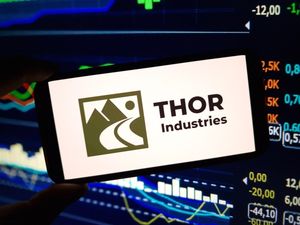
September 25, 2025 – The global copper market has been thrown into disarray following a force majeure declaration at the world-renowned Grasberg mine in Indonesia. Operated by Freeport-McMoRan (NYSE: FCX), the massive copper and gold complex halted operations after a devastating mudslide earlier in September 2025. This unforeseen supply shock has sent immediate ripples through financial markets, triggering a significant surge in the stock prices of numerous copper mining companies, while simultaneously pushing global copper prices to their highest levels in over 15 months.
The incident at Grasberg underscores the inherent fragility of critical mineral supply chains and the profound impact that disruptions at single, large-scale assets can have on global commodity markets. As the world increasingly relies on copper for electrification, renewable energy, and burgeoning AI infrastructure, the sudden reduction in supply from a mine responsible for approximately 3% of global output has intensified an already tight market, forcing investors and industry players to re-evaluate their strategies and outlooks.
Grasberg's Unforeseen Halt: A Detailed Look
The force majeure was officially declared by PT Freeport Indonesia, a subsidiary of Freeport-McMoRan (NYSE: FCX), following a catastrophic mudslide, or "mud rush," that occurred on September 8, 2025. This tragic event took place within the Grasberg Block Cave mine, where an estimated 800,000 metric tons of wet material inundated the operation. The incident resulted in the confirmed deaths of two workers, with five others still reported missing, prompting immediate rescue efforts and a temporary suspension of all mining activities on September 9.
The mudslide caused extensive damage to critical mine infrastructure, including mobile equipment, rail systems, and crucial electrical installations, rendering large sections of the mine inoperable. As a result, Freeport-McMoRan notified its commercial partners of the force majeure, signaling its inability to meet contractual obligations for copper and gold concentrate deliveries. Grasberg is not only the world's second-largest copper mine but also accounts for approximately 70% of PT Freeport Indonesia's projected copper and gold production through 2029, making its disruption a significant event for global supply. Initial market reactions were swift and dramatic: London Metal Exchange (LME) copper futures jumped by over 3%, breaking key resistance levels and touching $10,485 per ton, nearing the all-time high recorded in May 2024. Shares of Freeport-McMoRan, however, experienced a substantial decline, falling between 10.4% and 17% on the news, hitting a five-month low, reflecting the immediate operational and financial uncertainty facing the company.
Winners and Losers in the Copper Market Shift
The Grasberg force majeure has created a clear divide among public companies in the mining sector, establishing immediate winners and losers. At the forefront of those negatively impacted is Freeport-McMoRan (NYSE: FCX), the operator of the Grasberg mine. The company faces a dramatic downward revision in its production forecasts, anticipating negligible copper and gold sales from its Indonesian unit for the fourth quarter of 2025. Furthermore, Freeport projects that its 2026 production from Grasberg could be approximately 35% lower than previous estimates. While the company has activated business interruption insurance policies covering up to $1 billion, subject to a $500 million deductible, the significant loss of output (estimated at around 500,000 tonnes over 12-15 months) will undoubtedly weigh heavily on its financial performance and stock valuation in the short to medium term.
Conversely, other major copper producers have emerged as immediate beneficiaries of the supply disruption. Companies like Glencore PLC (LSE: GLEN), Teck Resources (TSX: TECK.B), Antofagasta (LSE: ANTO), Anglo-American (LSE: AAL), and Rio Tinto (ASX: RIO) all saw their stock prices climb following the Grasberg news. This rally is driven by the anticipation of higher copper prices resulting from reduced global supply, which will boost their revenues and profit margins. These diversified miners, with significant copper operations elsewhere, are poised to potentially capture a larger share of the market as overall supply tightens. Exchange-Traded Funds such as the Global X Copper Miners ETF (NYSEARCA: COPX) have also delivered significant year-to-date returns in 2025, reflecting broad investor confidence in the copper mining sector outside of the directly affected operations.
The event highlights the interconnectedness of the global commodity market, where a major disruption at one key asset can quickly redistribute value across the competitive landscape. For investors, the immediate strategy has been to divest from the directly impacted entity while flocking to competitors who stand to benefit from the resulting supply-demand imbalance and elevated prices.
Wider Significance and Industry Repercussions
The Grasberg force majeure is far more than an isolated incident; it serves as a stark reminder of several critical trends shaping the global mining industry. Firstly, it exposes the inherent fragility of global supply chains for critical minerals. With Grasberg alone contributing a substantial portion of global copper, its sudden cessation of production underscores how reliant the world is on a few concentrated sources for essential commodities. This vulnerability is particularly concerning amidst an intensifying copper market tightness, driven by surging demand from global electrification initiatives, the expansion of data centers, and renewable energy integration. The disruption further fuels projections of a structural deficit in copper supply, signaling an urgent need for new production capacity.
Secondly, the tragic mud rush in the sophisticated Grasberg Block Cave mine highlights the complex operational risks associated with advanced underground mining methods. Such incidents inevitably bring heightened scrutiny to mining companies' safety records and environmental management, reinforcing the industry's focus on robust safety protocols, risk management, and responsible operating practices to maintain social license and investor confidence. The event is expected to trigger a review of existing policies, potentially leading to stricter safety regulations for complex underground operations in Indonesia and other mining jurisdictions worldwide.
Historically, major mining disruptions, whether from operational failures, geopolitical shifts, or policy changes, have consistently reshaped commodity markets. Comparisons can be drawn to events like the Chuquicamata force majeure in 2019, or the more catastrophic tailings dam collapses at Samarco (2015) and Brumadinho (2019) in Brazil, which led to significant fatalities and production halts, driving increased scrutiny on safety and environmental compliance. Furthermore, geopolitical moves like China's rare earth export embargo (2010) and Indonesia's nickel ore export bans (2014, 2020) have demonstrated how government intervention and resource nationalism can dramatically reconfigure global supply chains. The Grasberg incident, occurring in the context of Indonesia's 2025 mining law amendments emphasizing local ownership and domestic processing, could further accelerate the government's focus on these policies, potentially influencing future investment in the country's mining sector and driving broader re-evaluations of supply chain resilience by governments and industries globally.
The Road Ahead: Navigating Copper's Future
The path forward for the copper market, post-Grasberg, is characterized by both significant challenges and emerging opportunities. In the short term, the market will grapple with continued price surges and intensified tightness. Goldman Sachs has already revised its 2025 global copper balance forecast from a projected surplus to a deficit of 55,500 tonnes, while other analysts predict a broader supply deficit ranging from 300,000 to 500,000 metric tonnes by the end of 2025. Freeport-McMoRan anticipates minimal sales from Grasberg in Q4 2025, with a phased restart of the main Block Cave not expected until early 2026, and a full recovery only by 2027. This prolonged disruption, coupled with existing supply challenges from other major producers like Codelco in Chile and political protests impacting mines in Peru, ensures increased market volatility and continued feedstock shortages for smelters.
Looking further ahead, the long-term implications are equally profound. The Grasberg incident exacerbates an already challenging supply landscape marked by critical project pipeline shortages, extended development timelines, declining ore grades, and a decade of underinvestment. These factors point to persistent structural supply limitations for years to come, potentially leading to a supply gap of up to 6 million tonnes annually by 2035. Consequently, major banks like Goldman Sachs maintain a bullish long-term outlook, targeting $10,750 per tonne by 2027, with Citi even projecting prices could reach $12,000-$14,000 per tonne in a bull case within the next 6-12 months. This sustained upward pressure is underpinned by robust demand growth from global electrification, the expansion of AI and data centers, and the accelerating adoption of electric vehicles, all of which are highly copper-intensive.
For mining companies, strategic pivots will be essential. This includes diversifying assets, increasing investment in new capacity and exploration, and enhancing safety protocols and technology adoption to mitigate operational risks. Governments, in turn, are likely to prioritize domestic supply security, fast-track permitting for major copper projects, and potentially engage in resource nationalism to secure greater control over critical minerals. New market opportunities will continue to emerge from the green energy transition and technological advancements, but these will be balanced by challenges such as geopolitical risks, environmental and social concerns delaying new projects, and potential economic headwinds. The overarching scenario points to a fundamentally tighter copper market, with the potential for significant price spikes and a continued re-evaluation of global supply chain resilience.
A Tighter Market Ahead: What Investors Should Watch
The Grasberg force majeure has undeniably marked a pivotal moment for the global copper market, cementing a shift into a deficit for 2025 and projecting prolonged impacts through 2027. The key takeaway is a market characterized by fragile supply against robust and growing demand, driven by the irreversible trends of global electrification, AI infrastructure, and renewable energy. This event serves as a potent reminder of the inherent risks in mining operations and the interconnected vulnerability of global supply chains for critical minerals.
Moving forward, the copper market is poised for continued strength and volatility. The disruption at Grasberg exacerbates existing supply challenges, suggesting that prices will remain well-supported, with a high potential for further spikes on any new supply setbacks elsewhere. The lasting impact will be a reinforced focus on the strategic importance of copper, prompting both mining companies and governments to prioritize investment in new production capacity, enhance risk management strategies, and explore supply chain diversification.
Investors should closely monitor several key indicators in the coming months. Firstly, copper prices themselves will be a primary focus; while current levels are high, analysts foresee potential for further rallies, with some long-term targets exceeding $12,000 per tonne. Secondly, supply updates from Freeport-McMoRan (NYSE: FCX) regarding the Grasberg mine's recovery timeline will be critical, as will any new developments from other major copper-producing regions, particularly Latin America. Thirdly, related equities will present varied opportunities: while Freeport-McMoRan (NYSE: FCX) may face near-term headwinds until clarity emerges, rival copper miners such as Glencore PLC (LSE: GLEN), Teck Resources (TSX: TECK.B), Antofagasta (LSE: ANTO), Anglo-American (LSE: AAL), and Rio Tinto (ASX: RIO) are likely to continue benefiting from elevated copper prices. Finally, global copper inventories and demand indicators from the energy transition and technology sectors will provide insights into the physical market's tightness and the underlying strength of consumption. The landscape is set for a dynamic period, where strategic positioning and vigilance will be paramount for investors in the copper space.
This content is intended for informational purposes only and is not financial advice.





